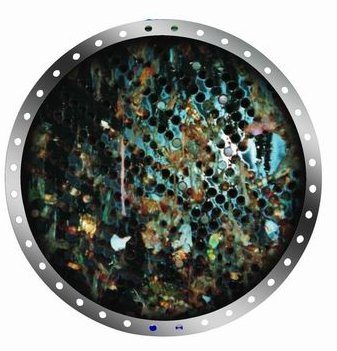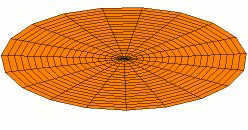|
Vibratory Shear-enhanced Process
Vibratory shear enhanced process (VSEP) is a membrane separation technology platform invented in 1987 and patented in 1989 by Dr. J. Brad Culkin. VSEP's vibration system was designed to prevent membrane fouling, or the build-up of solid particles on the surface of the membrane. VSEP systems have been applied in a variety of industrial environments. History and technology development After earning his PhD in chemical engineering from Northwestern University Dr. Culkin spent his early professional career with Dorr–Oliver, Inc., a pioneering company in the area of separation processes. Culkin contributed to six Dorr–Oliver patent applications in 1985 and 1986. While at Dorr–Oliver, Dr. Culkin was exposed to the advantages of membrane separation technology as well as its failings. The membrane's Achilles' heel, Culkin decided, was fouling. Concurrent with his membrane work, Culkin was helping to develop a mechanically resonating loudspeaker with the founders of Velodyne ... [...More Info...] [...Related Items...] OR: [Wikipedia] [Google] [Baidu] |
Northwestern University
Northwestern University is a private research university in Evanston, Illinois. Founded in 1851, Northwestern is the oldest chartered university in Illinois and is ranked among the most prestigious academic institutions in the world. Chartered by the Illinois General Assembly in 1851, Northwestern was established to serve the former Northwest Territory. The university was initially affiliated with the Methodist Episcopal Church but later became non-sectarian. By 1900, the university was the third largest university in the United States. In 1896, Northwestern became a founding member of the Big Ten Conference, and joined the Association of American Universities as an early member in 1917. The university is composed of eleven undergraduate, graduate, and professional schools, which include the Kellogg School of Management, the Pritzker School of Law, the Feinberg School of Medicine, the Weinberg College of Arts and Sciences, the Bienen School of Music, the McCormic ... [...More Info...] [...Related Items...] OR: [Wikipedia] [Google] [Baidu] |
Separation Process
A separation process is a method that converts a mixture or a solution of chemical substances into two or more distinct product mixtures, a scientific process of separating two or more substance in order to obtain purity. At least one product mixture from the separation is enriched in one or more of the source mixture's constituents. In some cases, a separation may fully divide the mixture into pure constituents. Separations exploit differences in chemical properties or physical properties (such as size, shape, mass, density, or chemical affinity) between the constituents of a mixture. Processes are often classified according to the particular properties they exploit to achieve separation. If no single difference can be used to accomplish the desired separation, multiple operations can often be combined to achieve the desired end. With a few exceptions, elements or compounds exist in nature in an impure state. Often these raw materials must go through a separation before t ... [...More Info...] [...Related Items...] OR: [Wikipedia] [Google] [Baidu] |
Membrane Separation Technology
A membrane is a selective barrier; it allows some things to pass through but stops others. Such things may be molecules, ions, or other small particles. Membranes can be generally classified into synthetic membranes and biological membranes. Biological membranes include cell membranes (outer coverings of cells or organelles that allow passage of certain constituents); nuclear membranes, which cover a cell nucleus; and tissue membranes, such as mucosae and serosae. Synthetic membranes are made by humans for use in laboratories and industry (such as chemical plants). This concept of a membrane has been known since the eighteenth century but was used little outside of the laboratory until the end of World War II. Drinking water supplies in Europe had been compromised by the war and membrane filters were used to test for water safety. However, due to the lack of reliability, slow operation, reduced selectivity and elevated costs, membranes were not widely exploited. The first use ... [...More Info...] [...Related Items...] OR: [Wikipedia] [Google] [Baidu] |
Achilles' Heel
An Achilles' heel (or Achilles heel) is a weakness in spite of overall strength, which can lead to downfall. While the mythological origin refers to a physical vulnerability, idiomatic references to other attributes or qualities that can lead to downfall are common. Origin In Greek mythology, when Achilles was an infant, it was foretold that he would perish at a young age. To prevent his death, his mother Thetis took Achilles to the River Styx, which was supposed to offer powers of invulnerability. She dipped his body into the water but, because she held him by his heel, it was not touched by the water of the river. Achilles grew up to be a man of war who survived many great battles. Although the death of Achilles was predicted by Hector in Homer’s '' Iliad'', it does not actually occur in the ''Iliad,'' but it is described in later Greek and Roman poetry and drama concerning events after the ''Iliad'', later in the Trojan War. In the myths surrounding the war, Achill ... [...More Info...] [...Related Items...] OR: [Wikipedia] [Google] [Baidu] |
Fouling
Fouling is the accumulation of unwanted material on solid surfaces. The fouling materials can consist of either living organisms ( biofouling) or a non-living substance (inorganic or organic). Fouling is usually distinguished from other surface-growth phenomena in that it occurs on a surface of a component, system, or plant performing a defined and useful function and that the fouling process impedes or interferes with this function. Other terms used in the literature to describe fouling include deposit formation, encrustation, crudding, deposition, scaling, scale formation, slagging, and sludge formation. The last six terms have a more narrow meaning than fouling within the scope of the fouling science and technology, and they also have meanings outside of this scope; therefore, they should be used with caution. Fouling phenomena are common and diverse, ranging from fouling of ship hulls, natural surfaces in the marine environment ( marine fouling), fouling of heat-transf ... [...More Info...] [...Related Items...] OR: [Wikipedia] [Google] [Baidu] |
Velodyne Acoustics
Velodyne Acoustics GmbH, commonly known as Velodyne, is a company that makes subwoofers and related products and was originally founded by David Hall in Silicon Valley, California, in 1983 and was then purchased in 2019 by Audio Reference of Hamburg, Germany, and its owner Mansour Mamaghani. The company also historically produced some headphone products and had a division called Velodyne Lidar that produced Lidar products and a division called Velodyne Marine that developed a boat stabilization technology. Velodyne founder David Hall spun off Velodyne Lidar as a separate company in 2016. Velodyne Marine is now also a separate company headquartered in Alameda, California, that remains owned by David Hall. As of February 2022, the post-acquisition Velodyne Acoustics company's described technologies included only subwoofers and subwoofer-related technology. History Audio equipment David Hall founded Velodyne in 1983 as an audio company specializing in low-frequency sound and ... [...More Info...] [...Related Items...] OR: [Wikipedia] [Google] [Baidu] |
Vibration
Vibration is a mechanical phenomenon whereby oscillations occur about an equilibrium point. The word comes from Latin ''vibrationem'' ("shaking, brandishing"). The oscillations may be periodic, such as the motion of a pendulum—or random, such as the movement of a tire on a gravel road. Vibration can be desirable: for example, the motion of a tuning fork, the reed in a woodwind instrument or harmonica, a mobile phone, or the cone of a loudspeaker. In many cases, however, vibration is undesirable, wasting energy and creating unwanted sound. For example, the vibrational motions of engines, electric motors, or any mechanical device in operation are typically unwanted. Such vibrations could be caused by imbalances in the rotating parts, uneven friction, or the meshing of gear teeth. Careful designs usually minimize unwanted vibrations. The studies of sound and vibration are closely related. Sound, or pressure waves, are generated by vibrating structures (e.g. vocal cords); ... [...More Info...] [...Related Items...] OR: [Wikipedia] [Google] [Baidu] |
Leachate
A leachate is any liquid that, in the course of passing through matter, extracts soluble or suspended solids, or any other component of the material through which it has passed. Leachate is a widely used term in the environmental sciences where it has the specific meaning of a liquid that has dissolved or entrained environmentally harmful substances that may then enter the environment. It is most commonly used in the context of land-filling of putrescible or industrial waste. In the narrow environmental context leachate is therefore any liquid material that drains from land or stockpiled material and contains significantly elevated concentrations of undesirable material derived from the material that it has passed through. Landfill leachate Leachate from a landfill varies widely in composition depending on the age of the landfill and the type of waste that it contains. It usually contains both dissolved and suspended material. The generation of leachate is caused principally ... [...More Info...] [...Related Items...] OR: [Wikipedia] [Google] [Baidu] |
Wastewater
Wastewater is water generated after the use of freshwater, raw water, drinking water or saline water in a variety of deliberate applications or processes. Another definition of wastewater is "Used water from any combination of domestic, industrial, commercial or agricultural activities, surface runoff / storm water, and any sewer inflow or sewer infiltration". In everyday usage, wastewater is commonly a synonym for sewage (also called sewerage, domestic wastewater, or municipal wastewater), which is wastewater that is produced by a community of people. As a generic term wastewater may also be used to describe water containing contaminants accumulated in other settings, such as: * Industrial wastewater: waterborne waste generated from a variety of industrial processes, such as manufacturing operations, mineral extraction, power generation, or water and wastewater treatment. ** Cooling water, released with potential thermal pollution after use to condense steam or reduce ma ... [...More Info...] [...Related Items...] OR: [Wikipedia] [Google] [Baidu] |



